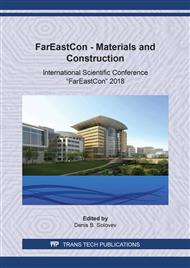[1]
P.P. Sharin, G.M. Nikitin, M.P. Lebedev, V.P. Atlasov, V.I. Popov, Patent RU 2607393. (2017).
Google Scholar
[2]
A.M. Isonkin, R.K. Bogdanov, Vliyanie metallizatsii almazov na pokazateli rabotosposobnosti burovykh koronok [Effect of diamond metallization on the performance of drilling bits], Naukovi pratsi DonNTU. Seriya «Girnicho-geologichna». 181 (2011) 158–163.
Google Scholar
[3]
P.P. Sharin, S.P. Yakovleva, V.E. Gogolev, M.I. Vasil'eva, Strukturnaya organizaciya vysokoiznosostojkih almazosoderzhashchih kompozitov na osnove tverdosplavnyh poroshkov, poluchennyh metodom spekaniya s propitkoj med'yu [Structural organization of highly wear-resistant diamond-containing composites based on carbide powders obtained by sintering with copper impregnation]. Perspektivnye materialy. 6 (2015) 66–77.
Google Scholar
[4]
T. Schubert, B. Trindade, T. Weißgärber, B. Kieback, Interfacial design of Cu-based composites prepared by powder metallurgy for heat sink applications, Materials Science and Engineering. 475 (2008) 39–44.
DOI: 10.1016/j.msea.2006.12.146
Google Scholar
[5]
A. Molinari, F. Marchetti, S. Cialanella, Р. Scardi, A. Tiziani, Study of the diamond-matrix interface in hot-pressed cobalt-based tools, Materials Science and Engineering: A. 130 (1990) 257–262.
DOI: 10.1016/0921-5093(90)90066-c
Google Scholar
[6]
D.A. Sidorenko, E.A. Levashov, P.A. Loginov, N.V. Shvyndina, E.A. Skryleva, I.E. Uskova, O mekhanizme samoproizvol'nogo plakirovaniya almaza karbidom vol'frama v processe spekaniya instrumenta s nanomodificirovannoj metallicheskoj svyazkoj Su–Fe–Co–Ni [Mechanism of spontaneous diamond plating with tungsten carbide during the sintering of a tool with nanomodified Cu-Fe-Co-Ni metal bond]. Izvestiya vuzov. Cvetnaya metallurgiya. 5 (2015) 53–63.
DOI: 10.17073/0021-3438-2015-5-53-63
Google Scholar
[7]
W. Tillmann, M. Ferreira, A. Steffen, K. Rüster, J. Möller, S. Bieder, M. Paulus, M. Tolan, Carbon reactivity of binder metals in diamond-metal composites –characterization by scanning electron microscopy and X-ray diffraction, Diamond and Related Materials. 38 (2013) 118-123.
DOI: 10.1016/j.diamond.2013.07.002
Google Scholar
[8]
W.S. Li, J. Zhang, H. Dong, K. Chu, S. Wang, Y. Liu, Y. Li, Thermodynamic and kinetic study on interfacial reaction and diamond graphitization of Cu-Fe-based diamond composite, Chinese Physics B. 22 (2013) 18102.
DOI: 10.1088/1674-1056/22/1/018102
Google Scholar
[9]
M.M. Yakhutlov, B.S. Karamurzov, Z.Zh. Berov, U.D. Batyrov, R.M. Nartyzhev, Napravlennoe formirovanie mezhfaznoj granicy almaz-matrica s ispol'zovaniem nanopokrytij [Directional formation of the interface boundary of a diamond-matrix using nanocoatings]. Izv. Kabardino-Balkarskogo gosuniversiteta. 1 (2011) 23–25.
Google Scholar
[10]
Yu.V. Naidich, V.P. Umanskii, I.A. Lavrinenko, Issledovanie prochnosti stsepleniya almaza s metallom [Study of the diamond-metal bonding strength], Sverkhtverdye materialy. 6 (1984) 19–23.
Google Scholar
[11]
P.P. Sharin, M.P. Lebedev, V.E. Gogolev, R.G. Nogovitsyn, P.A. Slobodchikov, Patent RU 2478455 (2013).
Google Scholar
[12]
J.L. Lauer, Raman Spectra of Quasi-Elemental Carbon, in: I.R. Lewis, H.G.M. Edwards (Eds.), Handbook of Raman Spectroscopy, Marsel Dekker, New York, 2001, pp.863-917.
Google Scholar
[13]
S.V. Tikhomirov, T.B. Kimstach, Spektroskopiya kombinatsionnogo rasseyaniya – perspektivnyi metod issledovaniya uglerodnykh nanomaterialov [Raman spectroscopy is a promising method for studying carbon nanomaterials], Analitika. 1 (2011) 28–32.
Google Scholar
[14]
V.A. Loktyushin, L.M. Gurevich, Poluchenie nanotolshchinnyh metallicheskih pokrytij na sverhtverdyh materialah metodom termodiffuzionnoj metallizacii [Obtaining nano-thick metal coatings on superhard materials by thermal diffusion metallization]. Izvestiya Volzhskogo gosudarstvennogo tekhnicheskogo universiteta. 11 (2009) 50–54.
Google Scholar
[15]
A.V. Nozhkina, Vliyanie metallov na fazovoe prevrashchenie almaza v grafit [The influence of metals on the phase transformation of diamond into graphite], Sverkhtverdye materialy. 3 (1988) 11–15.
Google Scholar
[16]
C.P. Bushmer, P.H. Crayton, Carbon self-diffusion in tungsten carbide, J.Mater.Sci. 6 (1971) 981-988.
DOI: 10.1007/bf00549949
Google Scholar
[17]
N.V. Tsypin, E.S. Simkin, G.D. Kostenetskaya, Metallograficheskoe issledovanie vzaimodeistviya almazov s metallami pri vysokikh temperaturakh [Metallographic study of diamonds interaction with metals at high temperatures], Adgeziya i paika materialov. 4 (1979) 78–80.
Google Scholar
[18]
Z.D. Lin, R.A. Queeney, Interface bonding in a diamond/metal matrix composite, in: Proceedings of the 1988 International Powder Metallurgy Conference, American Powder Metallurgy Inst., Orlando, 1997, pp.443-450.
Google Scholar
[19]
C.M. Sung, M.F. Tai, Reactivities of transition metals with carbon: Implications to the mechanism of diamond synthesis under high pressure, Intern. Jour. of Refractory Metals & Hard Materials. 15 (1997) 237-256.
DOI: 10.1016/s0263-4368(97)00003-6
Google Scholar
[20]
C. Artini, M.L. Muolo, A. Passerone, Diamond–metal interfaces in cutting tools: a review, Journal of Materials Science. 47 (2012) 3252-3264.
DOI: 10.1007/s10853-011-6164-6
Google Scholar
[21]
W.Q. Qiu, Z.W. Liu, L.X. He, D.C. Zeng, Y.-W. Mai, Improved interfacial adhesion between diamond film and copper substrate using a Cu (Cr)-diamond composite interlayer, Mater. Lett. 81 (2012) 155–157.
DOI: 10.1016/j.matlet.2012.05.015
Google Scholar


